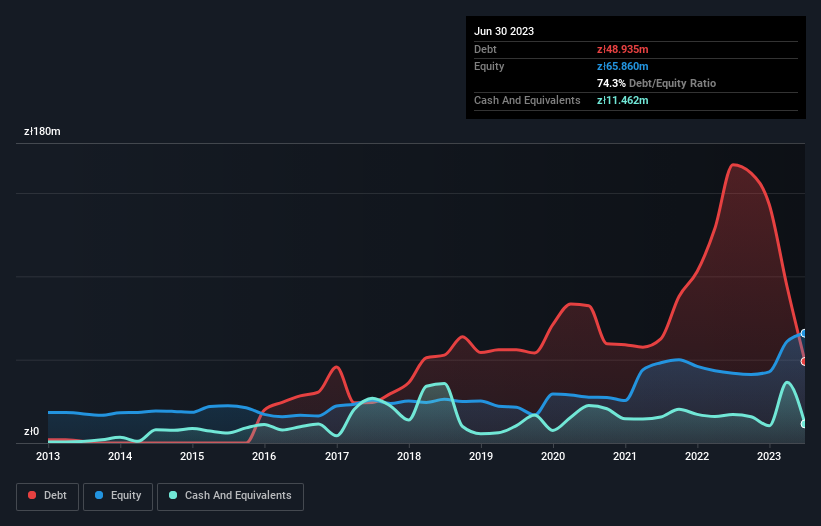The external fund manager backed by Berkshire Hathaway's Charlie Munger, Li Lu, makes no bones about it when he says 'The biggest investment risk is not the volatility of prices, but whether you will suffer a permanent loss of capital.' So it might be obvious that you need to consider debt, when you think about how risky any given stock is, because too much debt can sink a company. We can see that HM Inwest S.A. (WSE:HMI) does use debt in its business. But should shareholders be worried about its use of debt?
When Is Debt Dangerous?
Debt is a tool to help businesses grow, but if a business is incapable of paying off its lenders, then it exists at their mercy. Ultimately, if the company can't fulfill its legal obligations to repay debt, shareholders could walk away with nothing. However, a more common (but still painful) scenario is that it has to raise new equity capital at a low price, thus permanently diluting shareholders. Of course, debt can be an important tool in businesses, particularly capital heavy businesses. When we think about a company's use of debt, we first look at cash and debt together.
See our latest analysis for HM Inwest
What Is HM Inwest's Net Debt?
You can click the graphic below for the historical numbers, but it shows that HM Inwest had zł48.9m of debt in June 2023, down from zł167.0m, one year before. However, it does have zł11.5m in cash offsetting this, leading to net debt of about zł37.5m.

A Look At HM Inwest's Liabilities
The latest balance sheet data shows that HM Inwest had liabilities of zł38.8m due within a year, and liabilities of zł33.8m falling due after that. Offsetting these obligations, it had cash of zł11.5m as well as receivables valued at zł6.50m due within 12 months. So its liabilities outweigh the sum of its cash and (near-term) receivables by zł54.7m.
This deficit is considerable relative to its market capitalization of zł83.6m, so it does suggest shareholders should keep an eye on HM Inwest's use of debt. Should its lenders demand that it shore up the balance sheet, shareholders would likely face severe dilution.
We use two main ratios to inform us about debt levels relative to earnings. The first is net debt divided by earnings before interest, tax, depreciation, and amortization (EBITDA), while the second is how many times its earnings before interest and tax (EBIT) covers its interest expense (or its interest cover, for short). This way, we consider both the absolute quantum of the debt, as well as the interest rates paid on it.
Given net debt is only 1.1 times EBITDA, it is initially surprising to see that HM Inwest's EBIT has low interest coverage of 2.5 times. So one way or the other, it's clear the debt levels are not trivial. Pleasingly, HM Inwest is growing its EBIT faster than former Australian PM Bob Hawke downs a yard glass, boasting a 627% gain in the last twelve months. The balance sheet is clearly the area to focus on when you are analysing debt. But it is HM Inwest's earnings that will influence how the balance sheet holds up in the future. So when considering debt, it's definitely worth looking at the earnings trend. Click here for an interactive snapshot.
Finally, while the tax-man may adore accounting profits, lenders only accept cold hard cash. So the logical step is to look at the proportion of that EBIT that is matched by actual free cash flow. In the last three years, HM Inwest's free cash flow amounted to 24% of its EBIT, less than we'd expect. That's not great, when it comes to paying down debt.
Our View
On our analysis HM Inwest's EBIT growth rate should signal that it won't have too much trouble with its debt. However, our other observations weren't so heartening. In particular, interest cover gives us cold feet. When we consider all the factors mentioned above, we do feel a bit cautious about HM Inwest's use of debt. While debt does have its upside in higher potential returns, we think shareholders should definitely consider how debt levels might make the stock more risky. The balance sheet is clearly the area to focus on when you are analysing debt. However, not all investment risk resides within the balance sheet - far from it. Be aware that HM Inwest is showing 3 warning signs in our investment analysis , and 2 of those are concerning...
Of course, if you're the type of investor who prefers buying stocks without the burden of debt, then don't hesitate to discover our exclusive list of net cash growth stocks, today.
Valuation is complex, but we're here to simplify it.
Discover if HM Inwest might be undervalued or overvalued with our detailed analysis, featuring fair value estimates, potential risks, dividends, insider trades, and its financial condition.
Access Free AnalysisHave feedback on this article? Concerned about the content? Get in touch with us directly. Alternatively, email editorial-team (at) simplywallst.com.
This article by Simply Wall St is general in nature. We provide commentary based on historical data and analyst forecasts only using an unbiased methodology and our articles are not intended to be financial advice. It does not constitute a recommendation to buy or sell any stock, and does not take account of your objectives, or your financial situation. We aim to bring you long-term focused analysis driven by fundamental data. Note that our analysis may not factor in the latest price-sensitive company announcements or qualitative material. Simply Wall St has no position in any stocks mentioned.
About WSE:HMI
HM Inwest
Engages in the investment, development, and sale of real estate properties in Poland.
Slight with mediocre balance sheet.
Market Insights
Community Narratives



